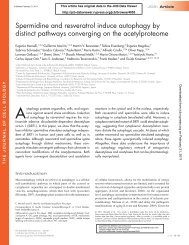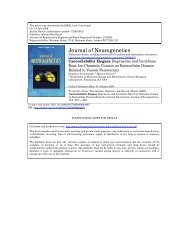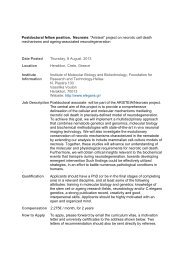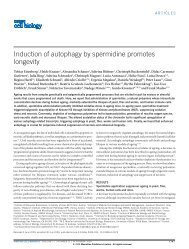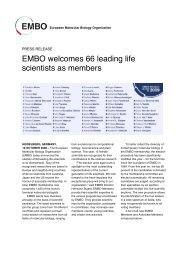CELL BIOLOGY OF THE NEURON Polarity ... - Tavernarakis Lab
CELL BIOLOGY OF THE NEURON Polarity ... - Tavernarakis Lab
CELL BIOLOGY OF THE NEURON Polarity ... - Tavernarakis Lab
Create successful ePaper yourself
Turn your PDF publications into a flip-book with our unique Google optimized e-Paper software.
Cell Biology of the Neuron: <strong>Polarity</strong>, Plasticity and Regeneration, Crete 2011<br />
Dendrite Morphogenesis and Functional Implications<br />
Yuh-Nung Jan , HHMI, UCSF<br />
For the past ten years, we have been trying to uncover the rules and the<br />
mechanisms that control dendrite morphogenesis by using a group of fly larval<br />
sensory neurons known as dendritic arborization (or da) neurons. We have gained<br />
some insights about dendrite development including how axons are dendrites are<br />
made differently, how a neuron acquires its neuronal type specific morphology,<br />
how the dendrites of different neurons are organized, how the size of a dendritic<br />
arbor is controlled, and how the pruning and remodeling of dendrites are<br />
regulated during development. Of the four different classes of da neurons, the<br />
dendrites of class IV da neurons form a regular array that tiles the larval body.<br />
Recently we found those neurons actually constitute a novel photoreceptor system<br />
using a photo-transduction pathway that is distinct from all the previously known<br />
ones. This regular array of photo-sensors enable the larvae to sense light exposure<br />
over its entire body to move out of danger.<br />
Previously, we found that the Hippo pathway plays important roles in controlling<br />
the dendritic arbor size and tiling of class IV da neurons. In Drosophila, Hippo<br />
Kinase regulate Tricorner (Trc) and Warts (Wts), the the only two members of<br />
Ser/Thr kinases of the NDR family in fly. Each Kinase then regulates<br />
complementary aspects of dendritic arbors: Wts controls maintenance where as<br />
Trc controls branching and tiling.<br />
To see whether our findings could be extended to mice, we study the two Trc<br />
homologues, NDR1 and NDR2, in mice. They share high sequence homology and<br />
both are ubiquitously expressed in the mouse brain throughout development. We<br />
find that NDR1/2 function to limit the complexity of the dendritic arbor of mouse<br />
hippocampal and cortical neurons, a role analogous to that of their fly and worm<br />
homologues. Additionally, we find a new function for NDR1/2: they are required<br />
for the proper development of dendritic spines. In order to gain insights<br />
concerning how NDR1/2 exert their functions, we set out to identify the<br />
substrates of their kinase activity. In collaboration with our colleague Kevan<br />
Shokat’s lab, we were able to apply their ingenious “chemical genetics and<br />
covalent capture method” to identify five NDR1/2 substrates and their<br />
phosphorylation sites. Strikingly, four have been implicated in vesicle trafficking.<br />
We chose two of them, AAK1 and Rabin8, for further studies. We were able not<br />
only to validate both as bona fide NDR1/2 kinase substrates but also found that<br />
AAK1 is preferentially required for controlling dentritic arbor complexity<br />
whereas Rabin8 is preferentially required for dendritic spine maturation – a<br />
finding that paves the way for dissecting the NDR1/2 pathway.<br />
Presented by: Jan, Yuh-Nung<br />
63



